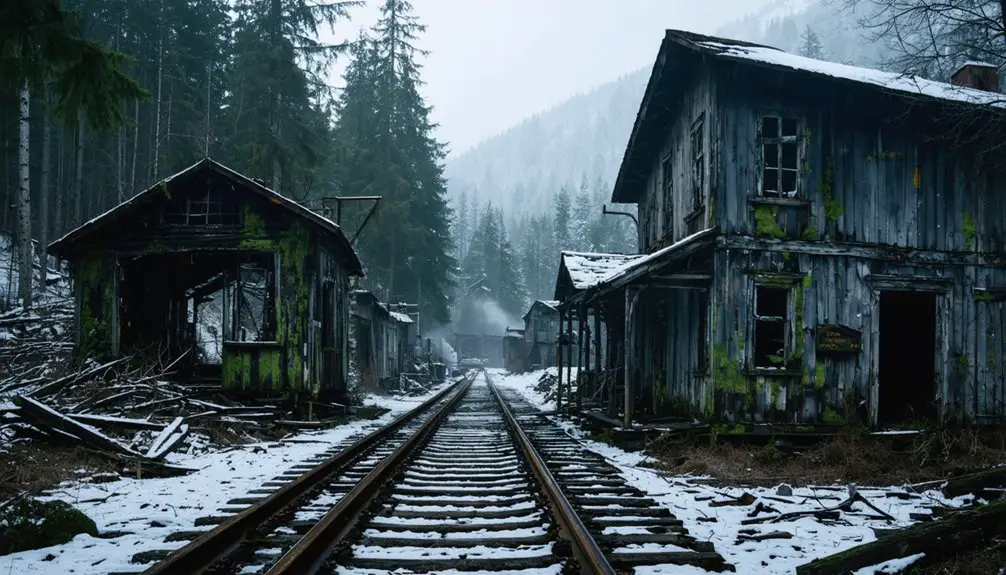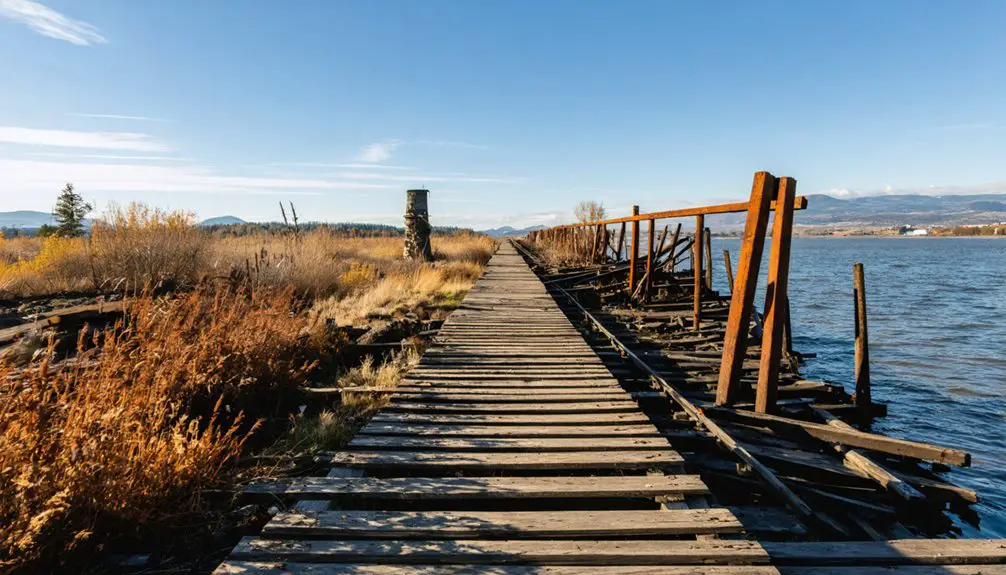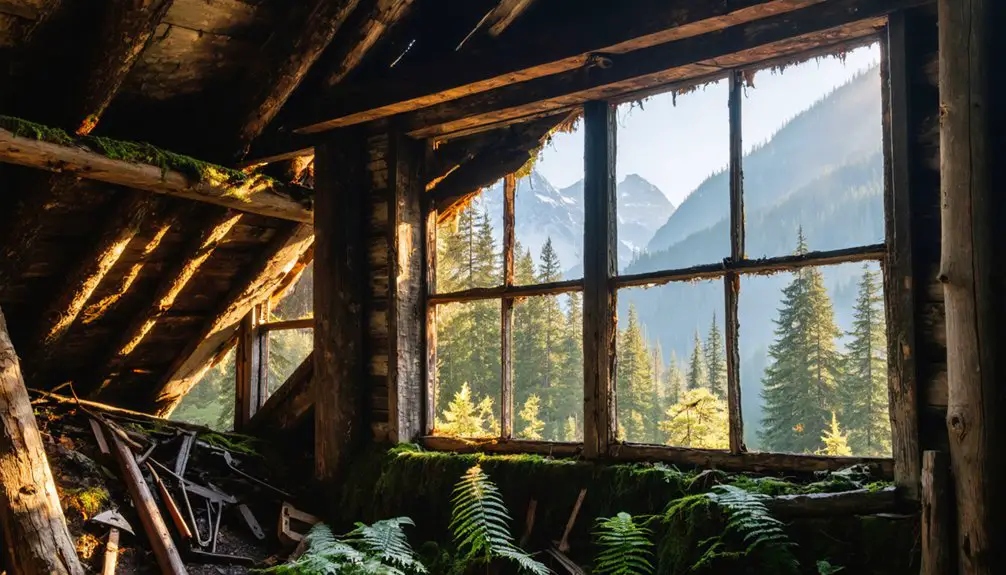You’ll find Wellington’s haunting remains along Washington’s Iron Goat Trail, where America’s deadliest avalanche claimed 96 lives in 1910. Originally established in 1893 as an essential Great Northern Railway stop, this ghost town witnessed both the triumph of railroad engineering and devastating tragedy. After the disaster, it was renamed Tye and operated until 1929. Today, crumbling foundations and abandoned railway beds tell a compelling story of human ambition against nature’s fury.
Key Takeaways
- Wellington became a ghost town after the 1929 completion of the new Cascade Tunnel made the original railroad station obsolete.
- The site’s tragic 1910 avalanche, which killed 96 people, contributed to its eventual abandonment and haunting historical legacy.
- The former town site is now accessible via the Iron Goat Trail, preserving remnants of railway structures and historical artifacts.
- After being renamed to Tye in 1910, the settlement gradually declined as improved railroad infrastructure bypassed the original location.
- The abandoned town’s remains sit at the west portal of the old Cascade Tunnel, marking a poignant reminder of early railroad history.
The Birth of a Railroad Town
When the Great Northern Railway sought to conquer the formidable Cascade Range in the late 19th century, they established Wellington as an essential railroad stop in 1893.
You’ll find this piece of railroad history nestled at the west portal of the original Cascade Tunnel, where it served as a critical resupply point for locomotives crossing the treacherous mountain pass.
The community dynamics of Wellington reflected its singular purpose – it wasn’t meant to be a thriving metropolis but rather a functional support hub for railway operations.
Nearly 800 workers, many of Japanese descent, built the tracks through this challenging terrain.
The town’s infrastructure focused entirely on serving the railroad’s needs, with everything from housing to maintenance facilities positioned strategically along the rail line for maximum efficiency. In October 1910, construction began on protective snowsheds to shield trains from dangerous avalanches. The original snowshed was expanded to reach 2,463 feet by 1916.
Life at the Mountain Pass
Despite its strategic location at Stevens Pass, life in Wellington presented formidable challenges to its hardy residents.
You’d find a tight-knit railroad community dynamics centered around the daily operations of the Great Northern Railway, with about 800 workers, including Japanese immigrants, maintaining the crucial mountain crossing.
Winter survival strategies became paramount as you faced brutal conditions that could strand you for days.
In Wellington’s harsh mountain winters, survival meant preparing for extended isolation while nature’s fury raged outside.
You’d hunker down in the utilitarian town’s structures – the hotel, train depots, and basic housing – while enduring relentless blizzards and the constant threat of avalanches.
The loss of protective forest cover to fire only heightened these dangers. Heavy snow accumulations of 5 to 8 feet frequently trapped residents and trains alike.
Without modern conveniences, you’d rely on fellow community members to weather the isolation, knowing that each snowfall could bring tragedy to your precarious mountain existence. The town’s general store, run by the Henrich Brothers, provided vital supplies for the stranded community.
The Fatal Nine Days
You’d be hard-pressed to imagine the sheer force of the nine-day blizzard that pummeled the Cascade Mountains in February 1910, trapping both a passenger train and mail train at Wellington Station.
Railroad superintendent James O’Neill faced an impossible choice: keep passengers aboard the relative safety of the trains or risk evacuation through waist-deep snow and treacherous conditions.
The conditions were reminiscent of Wellington, New Zealand, where southerly blasts can make winter temperatures feel brutally cold.
As the storm intensified and avalanches thundered nearby, the 119 passengers and crew members remained in their snow-bound prison, unaware that the mountain above would soon release its devastating fury.
This fateful decision would lead to one of the state’s darkest moments, as a sudden lightning strike triggered the avalanche that would claim 96 lives.
Blizzard’s Relentless Assault
As February 1910 descended upon Wellington, Washington, a devastating blizzard released its fury on the small railroad town, dumping snow at rates that overwhelmed train crews’ ability to keep the tracks clear.
The blizzard impact was relentless, pounding the region for six straight days while creating monstrous snow drifts up to 20 feet high around the depot.
You’d have witnessed nature’s cruel transformation as the heavy snowfall gave way to rain, creating treacherous conditions that only worsened with time.
The snow accumulation trapped two trains at Wellington, blocking their escape routes both east and west.
As passengers huddled inside their cars-turned-shelters, a violent lightning storm struck, setting the stage for an unimaginable catastrophe that would forever change the mountain community.
This catastrophic event would claim 96 innocent lives when the avalanche finally struck, making it the deadliest in American history.
Trapped Trains, Desperate Choices
When the blizzard finally subsided in late February 1910, two Great Northern Railroad trains remained hopelessly stranded at Wellington’s depot – their passengers and crew trapped in a desperate nine-day ordeal.
You’d find both trains perched precariously on the mountainside, where avalanche warnings had gone unheeded due to the impossible conditions. Most passengers chose to stay aboard rather than risk the treacherous trek down the mountain, unaware that their sanctuary would become their prison.
The town later changed its name to Tye to distance itself from the tragedy.
Survivor stories paint a grim picture of those final hours: the crack of thunder, the sudden roar of moving snow, and the violent descent that followed. For 96 souls, including 61 railroad workers, the choice to remain proved fatal.
The devastating avalanche, measuring a quarter mile wide, sent the trains plummeting 150 feet into the valley below.
Only 23 would emerge alive from the massive wall of snow and debris.
Final Hours Before Disaster
The nine days leading up to Wellington’s tragic avalanche unfolded like a slow-motion nightmare for those stranded at the depot.
You’d have witnessed nature’s mounting avalanche warnings as a relentless blizzard trapped two trains at the dangerous mountain pass.
In those final moments before disaster struck, the weather shifted ominously:
- Thunder and lightning pierced the night sky as snow turned to rain
- Unstable snowpack loomed precariously above the sleeping passengers
- Railroad crews fought exhaustion after days of futile snow clearing
- Passengers debated whether to abandon the relative safety of their cars
- The mountain’s deadly silence was broken only by distant rumbling
Just after 1:00 a.m. on March 1, 1910, the mountainside released its grip, sending a massive wall of snow toward the unsuspecting victims below.
The Night That Changed Everything
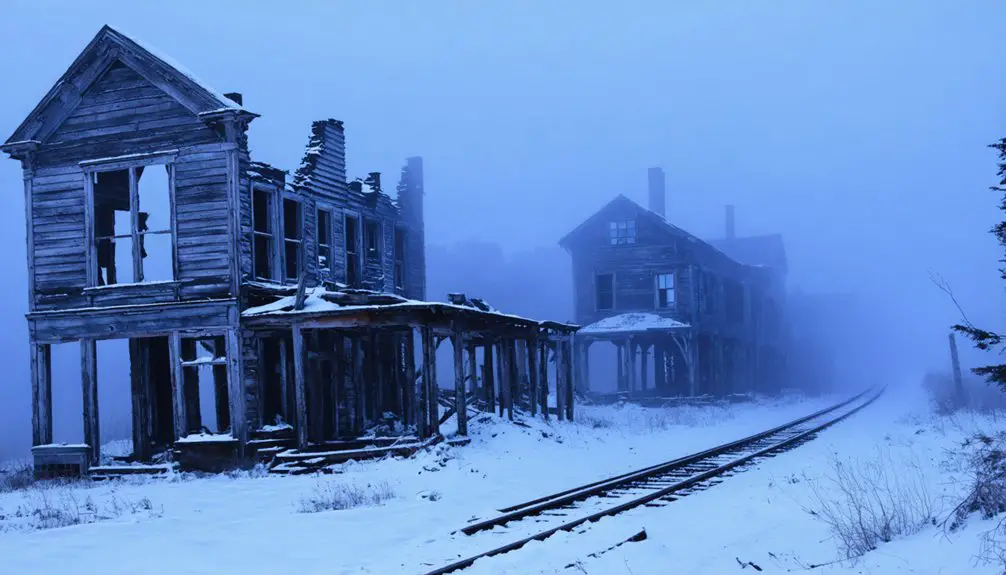
During the frigid night of March 1, 1910, a catastrophic avalanche forever changed the mountain town of Wellington, Washington.
While passengers and railway workers slept aboard two stranded trains, the mountainside above them finally gave way. The massive wall of snow plummeted 150 feet, violently sweeping both trains and the depot building into the Tye River valley below.
You’d find only 23 survivors among the wreckage, while 96 souls perished in America’s deadliest avalanche disaster.
The event sparked immediate changes in avalanche awareness and railway safety, leading to the construction of protective snow sheds.
Today, the abandoned site draws visitors who explore its haunting remnants along the Iron Goat Trail, with some reporting unexplained ghostly encounters amid the crumbling foundations and weathered snow sheds.
From Wellington to Tye
After the devastating avalanche claimed 96 lives, you’d find the Great Northern Railway quietly renaming Wellington to “Tye” in October 1910 to distance the location from its tragic associations.
You’ll notice this strategic rebranding coincided with the railway’s construction of concrete snow sheds, marking both a physical and symbolic fresh start for the mountain station.
As the community worked to shed its dark past, the new name “Tye” would represent the town’s final chapter until its abandonment in 1929, when the second Cascade Tunnel rendered the site obsolete.
Name Change Motivations
Five distinct motivations drove the October 1910 name change from Wellington to Tye, with the primary impetus being a desperate need to distance the town from America’s deadliest avalanche disaster.
The community response to the name change reflected a collective desire to move forward and rebuild.
You’ll find these key factors shaped the decision:
- Distancing from the March 1 tragedy that claimed 96 lives and deeply stigmatized the Wellington name
- Restoring traveler confidence in the Great Northern Railway’s Cascade Mountain route
- Creating a symbolic fresh start for survivors and remaining residents
- Aligning with local geography by adopting the Tye River valley reference
- Supporting broader infrastructure improvements, including new protective snowsheds
The shift marked a pivotal moment in the town’s brief history, blending practical safety concerns with psychological recovery needs.
Railway Station Rebranding
The rebranding of Wellington station to Tye in October 1910 reflected broader changes in Great Northern Railway’s infrastructure and safety protocols.
You’ll find this train branding shift came quickly after the devastating March avalanche, as the railway sought to distance itself from the tragic memories associated with the Wellington name.
As part of the disaster recovery efforts, you’ll see how the name change coincided with significant safety improvements, including the construction of nine miles of protective snow sheds between Scenic and Tye.
The devastating avalanche resulted in 96 total fatalities when two Great Northern Railway trains were swept into the valley below.
This rebranding strategy helped maintain passenger confidence while the railway implemented essential infrastructure upgrades.
The station continued operating as Tye until 1929, when the opening of the second Cascade Tunnel made the route obsolete, leading to the town’s eventual abandonment.
Community’s Fresh Start
When devastating avalanche memories threatened to permanently stigmatize Wellington in 1910, Great Northern Railway strategically rebranded the mountain community as Tye, marking a pivotal shift in the town’s identity.
You’ll find this identity transformation reflected in several key developments that showcased the community’s resilience:
- Construction of extensive snow sheds protecting nine miles of track
- Implementation of advanced engineering solutions, including a new tunnel at Windy Point
- Mobilization of hundreds of volunteers during rescue and recovery efforts
- Successful evacuation and treatment of survivors in nearby Wenatchee
- Development of improved safety measures to prevent future tragedies
While the name change couldn’t erase the tragic past, it represented a determined step forward.
The community’s commitment to rebuilding and adapting demonstrated their strength in the face of profound loss.
Engineering Solutions and Safety Measures
Following the devastating 1910 avalanche that claimed 96 lives, Great Northern Railway implemented thorough engineering solutions to prevent future disasters at Wellington.
You’ll find remarkable safety innovations in the concrete snow sheds constructed from October 1910, designed to shield trains from deadly snow slides. These protective structures featured small openings for light while keeping snow out.
The most significant engineering advancement came in 1929 with the completion of a new 2.6-mile Cascade Tunnel, rerouting trains beneath avalanche-prone areas.
The Cascade Tunnel, completed in 1929, proved revolutionary by safely routing trains under dangerous avalanche zones in the mountains.
They’d also improved operational protocols, training workers in avalanche safety and establishing emergency procedures for extreme weather. When conditions turned dangerous, you’d see trains safely held in protected shelters or tunnels.
Telegraph systems were integrated to provide essential weather alerts throughout the route.
The Town’s Final Days
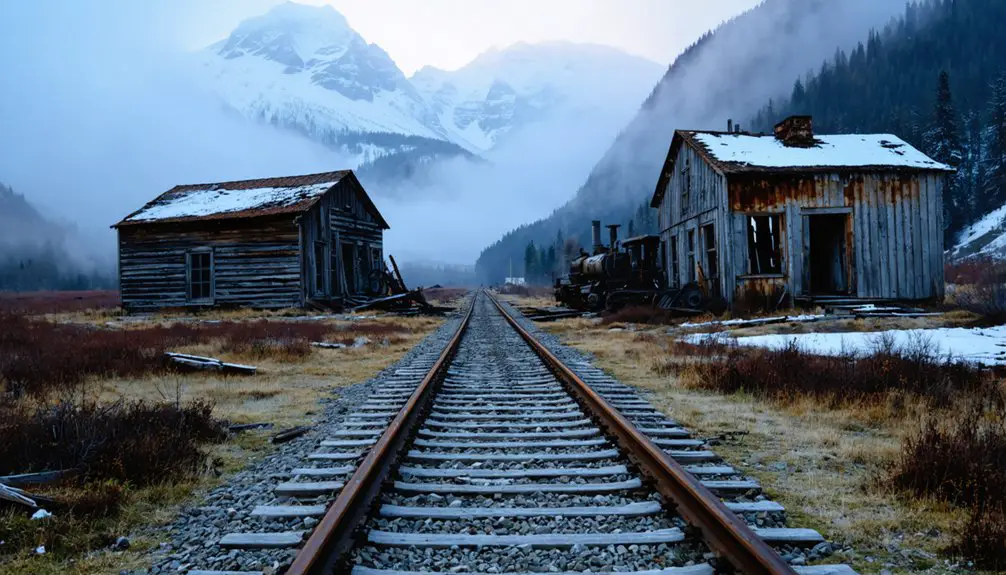
Despite efforts to rebuild and rebrand as “Tye” after the devastating 1910 avalanche, Wellington’s fate was sealed by a combination of tragic history and technological progress.
The social impact rippled through the community as residents grappled with the town’s identity change, while economic decline accelerated with each passing year.
You’ll find these key developments marked Wellington’s final chapter:
- The 1929 completion of the second Cascade Tunnel diverted rail traffic away from the town
- Railway depot closure eliminated the town’s primary economic lifeline
- Remaining residents gradually departed as job opportunities vanished
- A destructive fire consumed the last standing buildings
- The site transformed from bustling railway stop to abandoned ghost town
These events ended Wellington’s brief but dramatic history as a mountain railway community.
What Remains Today
Although time has erased most traces of Wellington’s once-bustling community, significant remnants of its railway infrastructure still stand as silent witnesses to the town’s dramatic past.
Today, you’ll find concrete snowsheds, the west entrance to the original Cascade Tunnel, and various foundations along the Iron Goat Trail. These ghost town remnants are accessible from U.S. Highway 2 near Stevens Pass, where a well-maintained parking area awaits visitors.
Visit concrete snowsheds and tunnel remnants along the Iron Goat Trail, easily accessible from Highway 2 near Stevens Pass.
While no residential buildings survived, historical preservation efforts have protected key railway structures, particularly on the eastern portion of the trail.
Interpretive signs guide you through the site’s history, and organized tours, including those by the Wing Luke Museum highlighting Japanese railroad workers’ contributions, help bring Wellington’s story to life.
The west end structures continue to deteriorate despite preservation attempts.
Legacy in American Railroad History
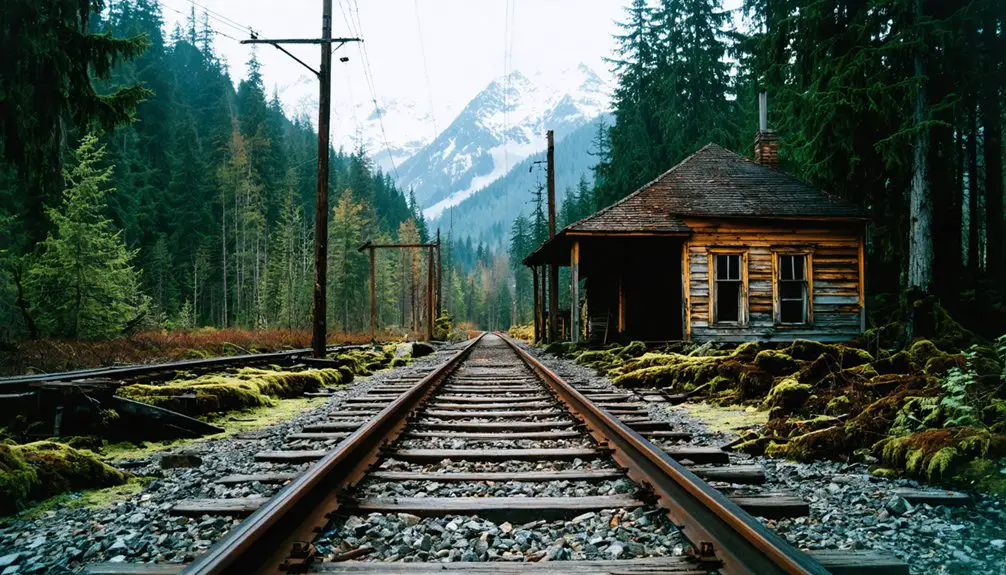
While many railroad towns faded into obscurity, Wellington’s tragic legacy permanently shaped American railroad history through its 1910 avalanche disaster and subsequent influence on mountain rail safety.
The catastrophe’s impact on railroad resilience and avalanche safety continues to resonate today.
- America’s deadliest railroad avalanche claimed 96 lives, forcing the industry to confront the dangers of mountain operations.
- The disaster led to significant route improvements, including the construction of a new tunnel away from avalanche-prone areas.
- You’ll find Wellington’s influence in modern railroad safety protocols and infrastructure design.
- The town’s story exemplifies the evolution from dangerous pioneer routes to sophisticated engineering solutions.
- Its legacy lives on as a reflection of the railroad industry’s commitment to protecting crews and passengers in challenging terrain.
Frequently Asked Questions
Are There Guided Tours Available to Visit the Wellington Ghost Town Site?
You won’t find guided tours specifically for Wellington, but you can explore its historical significance independently via the Iron Goat Trail’s interpretive signs, or join related railroad history tours through Wing Luke Museum.
What Personal Belongings or Artifacts Have Been Recovered From the Avalanche Site?
Like scattered puzzle pieces of history, you’ll find twisted train wreckage, railroad equipment, building foundations, rotted timbers from snow sheds, and depot ruins. Personal artifacts were likely recovered but rarely documented.
How Dangerous Is It to Visit Wellington’s Remains During Winter Months?
You’re facing extreme winter safety risks if you visit, including deadly avalanche risk, deep snow burial, and limited emergency access. Don’t attempt it without proper gear, experience, and monitoring forecasts.
Did Any Wellington Residents Stay in the Area After the Town’s Abandonment?
You won’t find any Wellington residents who stayed after 1929. When the new Cascade Tunnel rerouted trains away, everyone left since the railroad depot closed, and later fires destroyed remaining structures.
What Wildlife Encounters Should Visitors Be Prepared for at the Site?
You’ll likely encounter deer, squirrels, and various birds during your visit. Be prepared for possible black bear or coyote sightings, and keep your distance when observing any wildlife behavior.
References
- https://www.wta.org/go-hiking/hikes/wellington-ghost-town
- https://www.youtube.com/watch?v=YgmK9WpEKk8
- https://steemit.com/adventure/@lilyraabe/an-afternoon-jaunt-to-wellington-ghost-town-or-photo-album
- https://en.wikipedia.org/wiki/Wellington
- https://www.justfrances.com/ghosts-of-wellington-washington/
- https://www.ghosttownsofwashington.com/portfolio-collections/mines-king-county-wa/wellington
- https://www.americanhauntingsink.com/the-white-death
- https://washingtonourhome.com/the-1910-wellington-train-disaster/
- https://leerentz.wordpress.com/2012/08/07/iron-goat-trail-site-of-the-great-wellington-train-disaster/
- https://www.laurentarshis.com/22-i-survived-wellington-avalanche-1910
